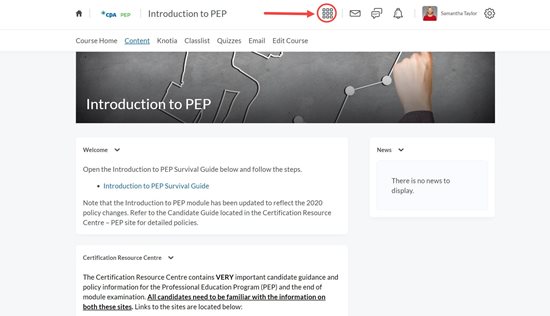
In my opinion, there are a few overlooked and underused resources for CPA PEP candidates. If used effectively, they can help you go from surviving to thriving. I’ve chosen these resources because, as I often reminded my team when I worked in industry, there are rarely accounting emergencies. Instead, we get caught in a spiral, usually because of poor preparation, lack of practice, or failure to reflect. The resources below pack in value and contain tools to help avoid that spiral through planning, practice and debrief.
1. Planning: Future module survival guides
The moment you register in your first module, you’re automatically registered in the Introduction to PEP Module. Go to your waffle; it’s the three-by-three icon in D2L, type keyword “Intro,” and “search” by selecting the magnifying glass to see the course.

There you will see all of the survival guides for the CPA PEP modules, which may be helpful to:
- Plan your year: leverage the survival guides and CPAWSB PEP schedules to ensure you have sufficient time to balance school, work, and life activities. If you know you have a challenging time at work or a well-deserved vacation, be strategic in your CPA PEP module registrations.
- Select your electives: you must pass at least two electives (though you can take three or even four!) before starting Capstone 1. Understanding the course requirements of each module may help you decide which electives are for you.
- Manage your stress: knowing the challenges that await may help put candidates at ease. Having access to the eBook in Knotia provides candidates with the opportunity to re-familiarize themselves with course content and perhaps get a start on required readings before the beginning of the module.
2. Practice: Exam sets
You can find Practice Exam Sets available under the Content section of Core and Elective module homepages. These are actual cases and MCQs that were used on previous examinations, which means they follow the module examination blueprint for your module and are a parallel representation of what you can expect to see on exam day. These have been provided for practice purposes, and previously I’ve outlined how to maximize their effectiveness by writing them in exam-like conditions.
3. Debrief: Examination results transcript
Pages four through seven of the CPA PEP Module Examination FAQ advise how to understand the feedback provided there. I cannot do it justice by summarizing and can only encourage you to review it for yourself. Here’s a sneak peek at the annotated infographic on page seven of a sample transcript:

You make many sacrifices to dedicate yourself to your studies. I encourage you to use available resources to help you achieve your goals.
Do you have feedback on this post or a question you’d like answered by an experienced CPAWSB educator? Please contact your facilitator or send a question to the General Topic in the Candidate Discussion forum.

Samantha Taylor, PME, CPA, CA, is an educator and lead policy advisor for CPAWSB, and an instructor of accounting at Dalhousie University. She is on a mission to understand and enable learner efficacy while eliminating doldrums occasionally associated with accounting education. Read more of Sam’s posts at the CPAWSB blog.




